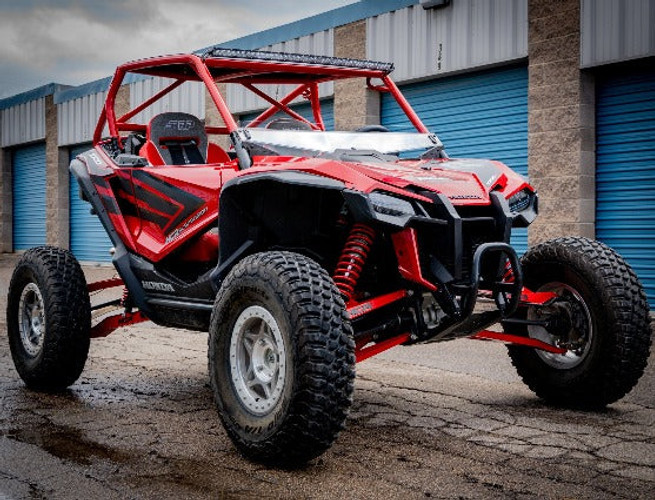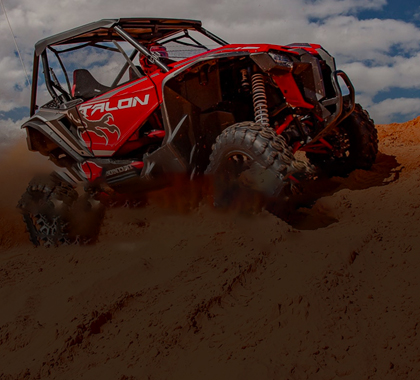Comparing UTVs: How Does The Honda Talon Stack Up?
Feb 25th 2020
Getting unbiased advice about the pros and cons of different side-by-sides is difficult. Similar to the Chevy vs Ford debate, a mixture of pride and brand loyalty seem to cloud the judgement of many UTV owners. Add to this the potential performance of specific off-road vehicles by adding aftermarket accessories / upgrades, and the murky waters of internet hearsay, biased anecdotes from friends and family, and the misaligned incentives of dealerships only exacerbates the confusion. In an attempt to clear the air and shed some light on the Honda Talon, we’re going to do an objective and impartial deep-dive into the matter, looking at the base models of the Talon R and Talon X to see how they compare to other leading side-by-side brands.
The Honda Talon Vs The Polaris RZR
To start things out, we’ll pit the Honda Talon against Polaris and their heavy-hitting RZR sport UTV. Upon first impressions, there are a few notable differences between the RZR and the Talon that might catch one’s attention. First of all, many folks find that the seat back of the Talon is not as comfortable as the RZR. However, it is designed to be used with an aftermarket 4-point or 5-point harness, which is a plus for safety considerations.
Taking a look at the gear shifters on both machines, the Honda Talon clearly comes out ahead. Unlike the primitive-feeling RZR shifter, the gear shifter on the Honda Talon is a refined work of art. Simply put it in gear and go, there’s nothing more to it. The CVT system on the RZR, however, requires you to give it a little gas to engage the gears, which is less intuitive and takes a bit of time to get used to.
In terms of instrumentation, chalk up another win to the Honda Talon. The items that need to be easy to read — like the speedometer, gear position, etc. — are just that. And with the option for gauge relocations as well as dash cubbies for things like radios, intercoms, and GPS units, there are many ways to customize your indicators and gauges.
Hill climbing in automatic is not the way to go in the Honda Talon. In manual, however, the Talon is pretty much unstoppable. And on the descent side, the Honda Talon downhill braking is truly amazing. Between the transmission downshifting and the EBD system, there is no comparison to the engine braking in the RZR.
For ride quality, many Honda Talon owners feel like their suspension is a little stiffer than the RZR, but this will vary depending on whether or not your Talon has FOX’s live valve suspension. Besides setting the shocks to the "soft" position, you can also adjust the preload on the Honda Talon springs. It’s not too difficult to do once you have the right spanners, and you can always go back to the original settings if you’re not satisfied with the ride performance.
Honda Talon Vs. The Can-Am Maverick
A big issue that many riders have with the Can-Am Mavericks is the noise level. Not only is the belt located right behind the cab, but the build quality is such that a lot of things rattle and shake. The visibility is also different in each machine. The XRC, for example, is a lot roomier in the cab, but you sit closer to the ground. In the Honda Talon, you sit higher up and have greater visibility. This is true not only for the driver, but the passengers as well. Your kids or other passengers in the back seats will also be able to see better.
If panache and bravado are your primary goals, the Can-Am X3 is your best bet. It is fun, fast, and loud, sure to turn heads and get you countless compliments. On the dunes, the Turbo X3 will generally outpace a Talon, but on tight and windy trails, the 72” wide X3 is harder to maneuver. The travel on the X3 is also bigger than the travel on the Honda Talon — 24 inches compared to 16 inches.
For trails and slower riding styles, a Honda Talon is the way to go. If, however, all you want is to go as fast as possible in wide-open areas all day every day, then a Can-Am might be a better choice. But remember, belts that constantly break might get annoying, and you can’t bet Honda where dependability is concerned.
Final Thoughts
Every machine has its place in the UTV world, and no vehicle can do it all. So when deciding between the various side-by-side brands, consider the type of terrain you’re going to ride. If it’s mostly sand, a Can-Am will do well. If it’s tight trails, the Talon is probably a better choice — unless you’re the type of person that has to haul ass everywhere. Compared to other side-by-side brands, Honda’s name carries enough weight to convince first-time side-by-side owners to enter the game. Honda is known for reliability, and when it comes time to sell your machine so you can buy the latest model, a Honda will likely sell better due to the reputation Honda has in the mind of consumers.
At the end of the day, you should go to dealerships, talk with them, and be straight forward when explaining your needs / situation. Do some test drives, ask to peak in their shops, and go from there. You can read spec sheets and compare anecdotes all day, but until you get behind the wheel, you’ll never know what feels right for you.




